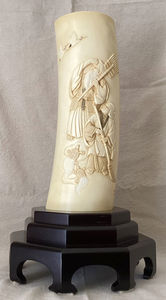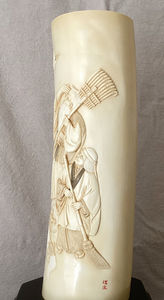Create Your First Project
Start adding your projects to your portfolio. Click on "Manage Projects" to get started
Ivory Tusk Vase The Legend of Takasago 34.6cm
A magnificent Japanese ivory tusk vase with inset Oribe pottery water /flower holder .
Using only the finest quality ivory this is an exquisite portrayal of the Legend Of Takasago, superbly carved in high relief.
An auspicious masterpiece displaying fidelity, wisdom, prosperity, good luck, and longevity.
Jo (尉) holding his rake, Uba (媼) holding her broom.
Overhead two Japanese cranes in flight, called tancho 丹頂鶴 meaning red crown, one of the rarest cranes in the world.
They are a symbol of good luck and longevity.
According to legend, they are said to live 1,000 years.
Near the feet of Jo and Uba are two Japanese “long-haired turtles", the Minogame, a mythical giant turtle from Japanese folklore, characterized by a long "tail" of seaweed and algae growing on its shell.
This "hair" is a symbol of great age, wisdom, and good fortune, with the creature believed to live for thousands of years and bring prosperity.
Signed by the famous artist carver : Nobuo Shimizu a descendant of the school of Koun Takamura who was a master of Japanese sculpture during the Meiji era , who specialised in wood carving .
Born in 1852, he became a master of Japanese sculpture during the Meiji era.
He trained in the traditional art of Buddhist statue carving but then integrated Western realism into his wood sculptures to create a new style of art.
He was appointed as an Artist to the Imperial Household (Teishitsu Gigeiin) in 1890, a high honour recognising his talent and status.
Along with his contemporary, Imperial artist Ishikawa Komei (1852-1913) who specialised in ivory carving.
A key figure in the early history of modern Japanese sculpture, Ishikawa Komei was born into a family of temple craftsman and from the age of ten studied painting for a time under Kano Kazunobu (1816–1863) before training as an ivory carver in the workshop of Kikugawa Masamitsu, a netsuke maker. Starting in 1876 he exhibited his work widely at home and abroad and participated in the interior decoration of imperial palaces. In 1890 he was named Teishitsu Gigeiin (Artist-Craftsman to the Imperial Household).
Various works by this artist Nobuo Shimizu have been sold in Japanese Art Galleries and at auction, from Yen 1,500,000 (A$15,000) to over Yen 20,000,000 (A$200,000).
Early 20th century.
Refer the large images for details & condition.
Please note... depending on your computer monitor / phone / ipad etc. colour may vary to actual.
Condition: Excellent, nice aged patina..
Dimensions are maximum measurements.
Height about : 38.5 cm (51cm with attached stand)
Width about: 12.3 cm (27cm on attached stand)
Ivory Weight about: 3050grams (3.05kgs), including fixed inset Oribe holder.
Total: 4.2 kgs including stand
A$13,500
The Takasago Legend 高砂伝説
This legend is one of the oldest in Japanese mythology.
Signifying a couple living in perfect harmony until they grow old together, they have long been a symbol of the happiness of family life.
At Takasago Shrine there is a very old pine tree, the trunk of which is bifurcated (相生の松); in it dwells the spirit of the Maiden of Takasago her name is Uba (媼), who was seen once by the son of Izanagi, his name is Jo (尉) who fell in love and wed her.
Both lived to a very great age, dying at the same hour on the same day, and since then their spirits abide in the tree, but on moonlight nights, they are said to appear from the mist at Lake Takasago .
They return to human shape to revisit the scene of their earthly felicity and pursue their work of gathering pine needles.
His pine tree is called "The Pine of Sumi-no-e" (住吉の松) and hers is the Takasago pine (高砂の松). The old woman is using a broom to sweep away trouble and he carries a rake to rake in good fortune.
In Japanese this is also a play of words with "One Hundred Years" (haku > sweeping the floor) and "until 99 years" (kujuku made > kumade, meaning a rake).
The story is portrayed in a famous Noh play "Takasago no Uta
Oribe Ware, also known as 織部焼 (Oribe-yaki), is a style of Japanese pottery that first appeared in the sixteenth century. It is a type of Japanese stoneware recognised by its freely-applied glaze as well as its dramatic visual departure from the more sombre, monochrome shapes and vessels common in Raku ware of the time .
The designs and glazing on most Oribe ware are richly colored, with blue, green, and copper glazes appearing most often.
The art of “High Relief Carving” in ivory involves many techniques The general shape of the figure /s is carved by removing large sections of ivory, reducing the background to the new level.
Figures are carved to project substantially from the background plane, often extending more than half their depth. Deep cuts are made behind the raised figures to increase the sense of depth and separation from the background.
Tools such as hand chisels, fretsaws, and drills are used for detail work, while techniques like undercutting create depth and can make figures almost detach from the background.
The process is labour-intensive, requiring superb skill, detailed planning, precise carving, and finishing.













































